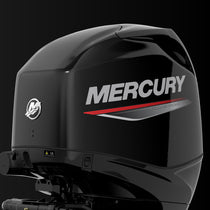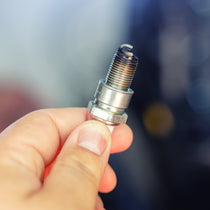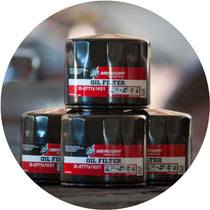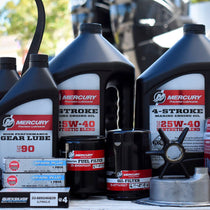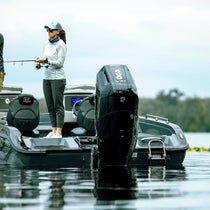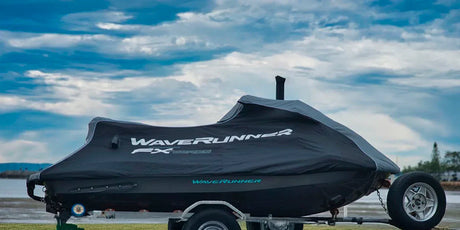Is your Mercury outboard water pump not functioning like it used to?
A water pump is a vital component of your outboard that can cause several serious performance issues when it fails. Because a bad outboard water pump will produce lower water pressure than normal operation, you may experience overheating, restrictions to available RPMs, and eventually, significant damage to the engine if not corrected.
However, it can be hard to tell if your Mercury outboard water pump is the cause of any issues - especially when all problems from the water pump may stem from a faulty water pump impeller.
In this article, we will take a look at several aspects related to your Mercury outboard water pump, including:
- How Do I Know If My Outboard Water Pump Is Bad?
- How Often Should You Change The Water Pump On Mercury Outboard?
- How to Replace Your Mercury Outboard Water Impeller

How Do I Know If My Outboard Water Pump Is Bad?
As mentioned in the introduction, the typical signs of a malfunctioning Mercury outboard water pump include:
- Overheating
- Reduced Outboard Performance
- Reduced Water Stream from the Tell Tale Hole
- Lack of Regular Maintenance (bad impeller)
Let’s take a look at these signs in depth.
Overheating
One of the sure signs that a water pump is acting up is if the motor temperature starts to climb during idle or while on plane.
Typically, the normal operating range for your Mercury outboard at idle should fall within the 120 - 140°F range, most commonly right around 125 - 132°F. On plane, your outboard’s temperature will vary widely based on the temperature of the water (colder in cold water, warmer in warmer temperatures).
If your temperatures begin to consistently rise above this range at idle, you should be concerned and not use your outboard until the problem is resolved. Also, if your overheating alarm goes off, you can be sure that some issue is driving the temperature up.
However, there are several other issues that cause overheating, such as:
- A faulty thermostat
- A worn impeller
- Blockages in the exhaust manifold
- Low engine oil
- Faulty/incorrect spark plugs
- and more (see PartsVu’s guide for diagnosing common outboard problems for more info)
Resolving or ruling out each of these issues may be necessary to troubleshoot your overheating Mercury outboard and determine if the water pump is the cause.
Reduced Outboard Performance
If you’ve noticed that your outboard doesn’t throttle up as normal and bogs down, you may have a malfunctioning water pump.
Essentially, the water pump won't consistently pump a steady stream of cooling water through the lower gearcase via the inlets on the side of the lower unit. Because of this irregularity, your engine will continually heat up and cool down, creating an intermittent bog during high RPMs as the engine compensates through reduced performance. This effect masks the issue until the water pump fails completely.
What makes this condition hard to diagnose is that at lower temperatures—during the winter months or when the water is cooler—the engine may cool off due to the environment and perform normally. Then, the bog will reappear in the warmer months, warmer water, or during extended usage.
Again, there are a number of causes for poor performance from your Mercury outboard motor besides a bad water pump, including:
- Tangled propeller
- Poor gas quality
- Clogged fuel filter
- Fuel hose replacement
- Faulty impeller
- Bad spark plugs
- Malfunctioning fuel pump
Refer to PartsVu’s guide “7 Reasons Your Outboard Will Not Throttle Up” to troubleshoot these issues before zeroing in on the water pump as the main issue.
Reduced Water Stream from the Tell Tale
Your Mercury outboard features a telltale hole, which emits a small, visible stream of water that passes through the powerhead. As the name implies, the tell tale helps indicate when cooling water is flowing to prevent overheating.
In most cases, a blockage often prevents water pressure from flowing efficiently from the hole. If you notice less-than-normal water falling from the hole or no water at all, insert a thin wire into the outlet to determine if it is blocked. Normal blockages include accumulated debris and salt (scaling), but insects often burrow into this hole. That is especially likley during periods when your outboard motor is being stored for the winter.
If the tell tale hole is clear and the lack of flow continues, you might have a damaged pump housing instead. In this case, you may notice water flowing from another place on your outboard, such as a crack in the water pump housing.
And if no water is flowing, the chances are that either the water pump needs to be replaced or a worn impeller is the source of the issue.
Lack of Regular Maintenance (Bad Impeller)
Just like any other engine, Mercury outboard motors require maintenance at regularly scheduled intervals. These maintenance intervals typically occur every 100 hours of service and enhanced service every 300 hours. That works out to every year and three years, respectively.
Failure to perform maintenance after heavy usage or according to these time spans often leads to degraded performance of your outboard - particularly for many of the reasons under the “Overheating” and “Poor Engine Performance” headings above.
For 300 hours of service (3 years), changing out your water pump impeller is recommended - a relatively common repair. Located just above the lower gear case assembly, the impeller is a rubber star-shaped component that is keyed to the driveshaft. Through rotation, the impeller's job is to pump cold water by drawing water from the intakes into the housing to cool the engine down consistently.
However, through usage and age, the flexible vanes of the impeller wear out, reducing water flow. If your outboard sits for an extended period, the fins of the impeller can become brittle and degrade.
To make this repair a cinch, PartsVu offers complete water pump impeller replacement kits. These kits come with everything you need to complete the repair as part of your regularly scheduled maintenance - or simply for peace of mind to preserve your outboard (see the guide for replacing your Mercury outboard water pump impeller below).
If you’ve performed complete maintenance on your Mercury outboard and still experience issues, it is reasonable to suspect that a failing water pump is the issue.
How Often Should You Change the Water Pump On Mercury Outboard?
In most cases, you won't need to replace the water pump unless the housing is damaged.
Instead, replacing the water pump impeller every three years or sooner should avoid most water-pump-related issues and keep your outboard running in excellent condition.
However, if you've noticed persistent problems keeping your engine cool, you may need to replace the water pump completely. Bear in mind that replacing the entire water pump is a significant repair for your Mercury outboard motor.
How to Replace Your Mercury Outboard Water Impeller
Most Mercury outboards follow a similar design, so the following guide will apply to most models. The next steps will guide you through the basics for a 60 hp Mercury outboard water pump replacement:
Tools Needed
- Ratchet
- Socket (10mm for most models)
- Parts
Parts Needed
Step 1: Begin by removing the gearcase/lower unit from the outboard.
Step 2: Next, remove the rubber water tube seal from the top of the water pump assembly.
Step 3: Remove the four bolts that hold the water pump assembly in place (Note: there may be a fifth bolt located above the propeller, depending on your outboard model).
Step 4: Remove the water pump housing.
Step 5: Remove the impeller, including the two (2) nylon washers, located above and below the impeller.
Step 6: Remove the woodruff key from the base of the driveshaft.
Step 7: Remove the upper gasket, the wear plate, and the lower gasket from the gearcase.
Step 8: Inspect the shift shaft boot for cracks or splits. If it is worn, replace it with a new one.
Step 9: Install the new lower gasket, wear plate, and upper gasket with the neoprene side of the upper gasket facing upward.
Step 10: Install the new impeller with the nylon washers above and below it. Make sure the impeller sits over the woodruff key for a proper installation.
Step 11: Grease the inside of the water pump housing and the top of the wear plate with marine grease.
Step 12: Reinstall the water pump housing while rotating the driveshaft clockwise. This will ensure that the impeller blades are turned in the correct direction within the water pump housing.
Step 13: Reinstall each of the four water pump assembly bolts.
Step 14: Install the new rubber water tube seal onto the top of the water pump assembly.
That’s it. Congratulations on replacing your water pump impeller!

How Much Does It Cost to Replace A Water Pump Impeller On A Mercury Outboard?
Replacing the impeller is a relatively inexpensive and straightforward repair. Depending on your model of Mercury outboard, you can expect only to pay between $15 - $35 per impeller. However, you will want to replace other components, so it is highly recommended that you purchase a water impeller kit from PartsVu to have everything you need on hand to perform a complete job. Additionally, we carry may other boating essentials to help you to enjoy your time on the water to its fullest.
Care and maintenance of your marine engine are critical. If properly maintained, it will last for many, many years. Now that you know everything that there is to know about maintaining your Mercury outboard water pump, it’s time to get to work so you can enjoy worry-free time out on the water!
This content was designed to serve as a general guide. Persons who are not familiar with marine engine repair and who have not been trained in the recommended servicing or installation procedures should have the work performed by an authorized marine mechanic. Improper installation or servicing of parts can result in engine or boat damage, personal injury to the installer, or harm to persons operating the product.


